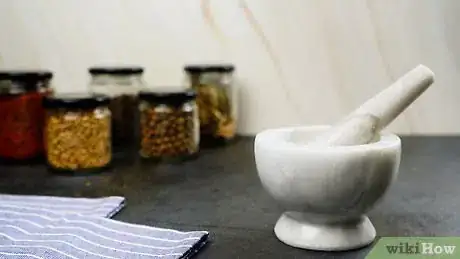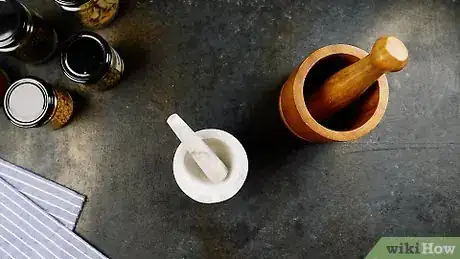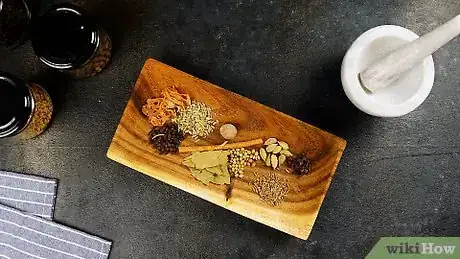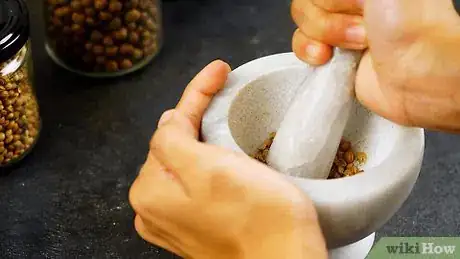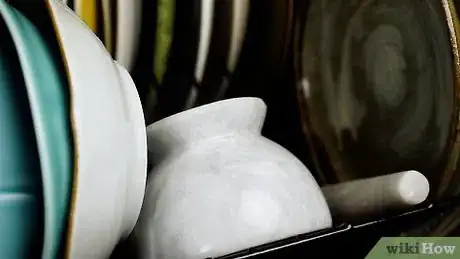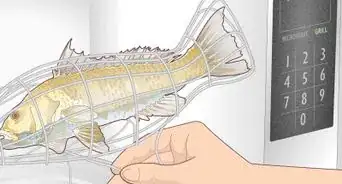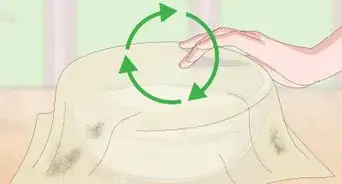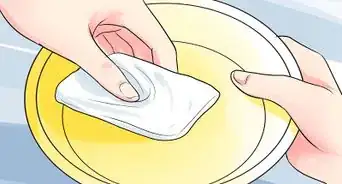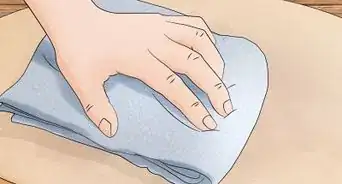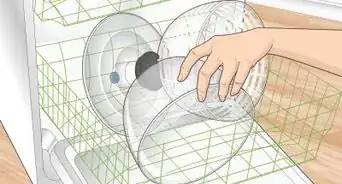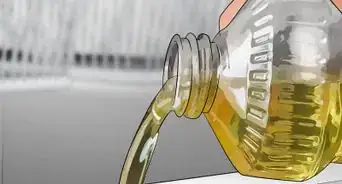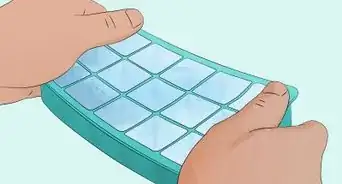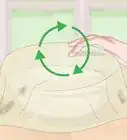This article was co-authored by Alessandra Mendes. Alessandra Mendes is a Cleaning Specialist and the Founder of Cleaning Glow. With ten years of experience, Alessandra and her team specialize in providing residential cleaning services in the San Francisco Bay Area. All members of the Cleaning Glow team have completed thorough background checks.
There are 7 references cited in this article, which can be found at the bottom of the page.
wikiHow marks an article as reader-approved once it receives enough positive feedback. In this case, 100% of readers who voted found the article helpful, earning it our reader-approved status.
This article has been viewed 378,360 times.
When you've graduated beyond pre-packaged spices and you're ready to grind your own fresh cinnamon, cloves, peppercorn, cumin and more, there's no more useful tool than a mortar and pestle. Spices, garlic, nuts or seeds are placed in the mortar, then crushed with the pestle, releasing their fresh flavors and oils. You'll really notice the difference in taste! See Step 1 to learn how to use a mortar and pestle to step your cooking up a few notches.
Steps
Choosing a Mortar and Pestle
-
1Choose the size you want. Do you want to crush large amounts of spices, seeds, and nuts, or only small amounts? You will find varying sizes from palm size to bowl size, and it may even be handy to have two different sizes if you have the space and budget for it.
- If you plan to grind a very large amount of spices, getting a spice grinder may be more suitable for your needs. A mortar and pestle is best for just enough spices to create whatever dish or spice mix you immediately want to use.
-
2Pick the right material for your needs. Mortar and pestles are usually made in a matching set. The mortar is a small bowl and the pestle is a wand with a curve that's perfectly shaped to grind smoothly against the mortar. The instrument may be made from wood, stone or ceramic, and you'll want to choose your material based on your culinary needs and personal preferences.[1]
- Ceramic mortar and pestles are capable of grinding spices very finely, but they're also more fragile than other types.[2]
- Wood mortar and pestles are durable, but they're also slightly porous, and subject to stains. It's also possible for the flavor of one spice to stay present in the mortar between uses, tainting the flavor of the next spice you grind.
- Stone mortar and pestles also grind very finely, but unless they're conditioned properly, fine particles of stone can get ground into the spices.
Using a Basic Technique
-
1Read the recipe for processing instructions. If you need something ground into a paste or powder, this is the ideal tool. Items that are good to grind or crush in the mortar and pestle include peppercorns, spice seeds, herb seeds, fresh herb and spice leaves, rice, nuts, other plant seeds, hard candies, sea salt, and so on. Anything used for baking or eating that can be crushed is likely to work in the mortar and pestle.
- If you need something chopped, pureed, or blended, you may be better off with another tool, such as a blender or processor. The recipe will often be a guide on this.
-
2Place the raw ingredients in the mortar. Measure out your whole peppercorns, cinnamon, or other ingredient and place it in the mortar. Fill the mortar no more than ⅓ full with raw spices; otherwise, it will be difficult to get an even grind. If you have too much to fit, it's fine to process the spices in batches.
-
3Use the pestle to process to your desired consistency. Hold the mortar in place with one hand, take the pestle in your opposite fist, and twist it against the ingredients in the mortar so that they are ground against its bottom and sides. Evenly grind, bash or crush all of the spices, using the pestle to mix and grind them until they are all reduced to the same consistency. Continue until the ingredients are as coarse or fine as you want.
- See below to learn specific techniques for grinding, crushing or bashing your ingredients. Each technique will result in a different consistency, and can affect the flavor and final outcome of your dish.
-
4Store or measure out the ingredients. You can either place the freshly ground contents of the mortar into a glass spice jar with a tight-fitting lid, or go ahead and measure out how much you need for your recipe.
Trying Other Grinds
-
1Use the mortar and pestle to grind. This is the ideal technique for most spices you'll use in baked goods, sauces and other dishes. You can grind to a coarse, medium or fine consistency.[3]
- Place your ingredients in the mortar and hold it in place with one hand.
- Hold the pestle in your fist with a firm but comfortable grip.
- Press the rounded end of the pestle down onto the ingredients and roll it against the mortar while applying firm pressure.
- Grind until you've reached your preferred consistency.
-
2Use pounding for large spices and seeds. If the item resists or is simply large and needs this approach, use firm but gentle pounding, sometimes called bashing. This will crack the spices, allowing you to switch techniques to get a finer grind.[4]
- Grind first. This action will catch the ingredients that crush easily and make the pounding easier.
- Pound or bash the ingredients. Use the broad end of the pestle and bring it down gently. Use short, sharp pounds to speed up the process and conserve your own energy.
- To avoid mishaps, cup your other hand (or a small cloth) over the top opposite side of the mortar and pestle to catch any of the bashed item that tries to bounce out.
- Grind again if needed. Once most of the ingredients have been crushed, a little end muddling may assist to finish off the crushing.
-
3Use crushing to keep spices intact. If your recipe calls for crushed, rather than ground, spices, that means they shouldn't be completely pulverized. Instead, you want to keep them mostly intact. This is also a suitable technique for processing garlic.[5]
- Place the ingredients in the mortar.
- Roll the pestle across the ingredients so that they crush and burst.
- Continue until all of the ingredients have been crushed, but not finely ground.
Cleaning a Mortar and Pestle
-
1Clean your mortar and pestle after use. The cleaning approach is dependent on the material of the mortar and pestle. Check the instructions that came with the mortar and pestle you bought to ensure you clean it properly. Here are some broad advisories:
- For a dishwasher-safe mortar and pestle, simply place in the usual dishwasher cycle.
- If you have a wooden set, don’t submerge it in water or put it in the dishwasher. Instead, wipe it clean with a damp cloth and let it air dry.
- For a dry grind, it may be sufficient to simply brush out with a clean cloth or paper towel.
-
2Don't use soap if you can help it. Since most mortar and pestles are a little porous, soap can leave an ill-tasting residue that can get mixed in with your spices next time you grind something. Wiping it out with warm water, then drying it thoroughly should do the trick.
-
3Try using dry rice for tough smells and stains. Sometimes it's difficult to remove smells and stains from strong spices. A good trick is to pour some dry white rice into the mortar, then use the pestle to grind it finely. The rice will probably take on the color and smell of the last spice you processed. Discard the rice, then repeat the process until the ground rice remains white and odor-free after the grinding.
Community Q&A
-
QuestionJust bought a stone mortar and pestle with no instructions in the box. How do I condition it prior to first use?
 Community AnswerGrind some dry rice for about 15 minutes, then for 5 minutes with a little olive oil added to form a stiff paste. That will really polish up the inside, so removing the fine stone dust. Wash out with warm water and allow to air dry. Do not use any detergent at all, as this taints both the mortar and pestle.
Community AnswerGrind some dry rice for about 15 minutes, then for 5 minutes with a little olive oil added to form a stiff paste. That will really polish up the inside, so removing the fine stone dust. Wash out with warm water and allow to air dry. Do not use any detergent at all, as this taints both the mortar and pestle. -
QuestionWhat mortar and pestle should I use for powdering or fine grinding of medical tablets or pills?
 Community AnswerIf you mean what size, use a small one. If you mean what kind, use ceramic or wooden. Stone mortar and pestles aren't the best because they can leave bits of stone if you're not careful.
Community AnswerIf you mean what size, use a small one. If you mean what kind, use ceramic or wooden. Stone mortar and pestles aren't the best because they can leave bits of stone if you're not careful. -
QuestionHow do you make paste with a mortar and pestle?
 Niles HardingCommunity AnswerFirst, grind the dry ingredients to the desired consistency (coarse to dusty). Then, add your liquid in individual, small portions (start with ~5-10% of the powder volume), and continue to mix with the pestle. The dry ingredients should start to be coated by the liquid. Continue to add small amounts of liquid, followed by more mixing until the desired consistency is reached. This process is called trituration.
Niles HardingCommunity AnswerFirst, grind the dry ingredients to the desired consistency (coarse to dusty). Then, add your liquid in individual, small portions (start with ~5-10% of the powder volume), and continue to mix with the pestle. The dry ingredients should start to be coated by the liquid. Continue to add small amounts of liquid, followed by more mixing until the desired consistency is reached. This process is called trituration.
Warnings
- If you make your own mortar, the inside should never be glazed or polished.⧼thumbs_response⧽
- Be careful that any mortar and pestle used for toxic or harmful substances is never reused for foods. Do not even keep such a mortar and pestle in the kitchen. Instead, place it with your hobby/gardening/chemistry experiment gear and label it clearly.⧼thumbs_response⧽
- One caution about pounding: Ceramic, stone, and wood mortars can be fractured if struck when they are empty or if they are struck too hard. Most metal mortars should be used only for relatively soft materials to avoid pitting or spalling.⧼thumbs_response⧽
- Ask a pharmacist before crushing medicines. Some drugs may be absorbed too quickly when crushed.
- Never crush or chew pills which have an enteric coating (may also be labeled as 'gastro resistant').[6] Pills with enteric coatings look like clear capsules with a powder or liquid inside. Breaking one in half will spill the powder or liquid, and then consuming it afterwards will seriously upset your stomach.[7]
⧼thumbs_response⧽
References
- ↑ https://www.seriouseats.com/2018/08/best-mortars-and-pestles.html
- ↑ https://www.washingtonpost.com/lifestyle/food/mortar-and-pestles-for-different-jobs/2012/03/08/gIQAgisY9R_story.html?utm_term=.b788d3b31746
- ↑ https://www.npr.org/sections/thesalt/2012/11/25/165596088/real-chefs-grind-it-with-a-mortar-and-pestle
- ↑ https://food.ndtv.com/food-drinks/how-to-use-a-mortar-and-pestle-6-tips-to-grind-spices-better-1779051
- ↑ https://foodal.com/kitchen/general-kitchenware/spice-grinders/best-mortar-and-pestle-set-reviews/
- ↑ https://www.sciencedirect.com/science/article/pii/S1665579617300248
- ↑ https://www.the-hospitalist.org/hospitalist/article/124093/crush-or-not-crush
About This Article
To use a mortar and pestle, start by placing the raw ingredients you want to grind up in the mortar. Then, hold the mortar in place with one hand and the pestle in your other. Press the end of the pestle against the ingredients and twist it back and forth until everything is ground up evenly. When you're finished, pour the ground up ingredients into your recipe or store them in a glass jar. To learn how to grind large spices and seeds with a pestle, scroll down!
